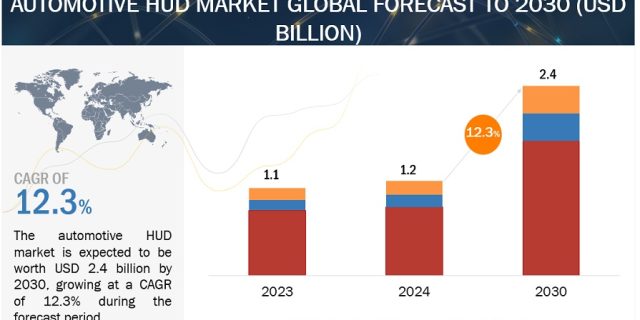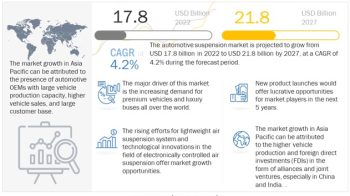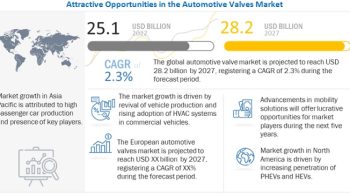
The global automotive HUD market size is projected to grow from USD 1.2 billion in 2024 to USD 2.4 billion by 2030, at a CAGR of 12.3%. With the increase in awareness of the safety of vehicles and passengers Demand for better In-vehicle experience, growing preference towards connected vehicles steady increase in the market for premium and luxury vehicles, primarily in emerging markets are expected to increase the demand for automotive HUD solutions all over the world. Moreover, increasing adoption of electric vehicles along with growing demand for semi-autonomous vehicles are also expected to create lucrative opportunities for the automotive HUD market in the coming years globally.
Automotive HUD Market Dynamics:
Driver: Steady growth in demand for luxury and high-end segment cars, mainly in emerging markets
The revenue growth of the automotive HUD market is expected to be supported by the consistent growth in demand for luxury vehicles during the forecast period. Automotive HUD technology was first introduced by luxury cars. Luxury car manufacturers have integrated HUDs into their top-of-the-line models after realizing how valuable they are for enhancing the driving experience. For example, automotive HUDs are available for the Audi Q4 e-tron, BMW iX, BMW iX3 (RR), and Mercedes-Benz EQE. Furthermore, cutting-edge features and technologies are frequently introduced into luxury cars. As a result, technological developments in car HUDs for luxury vehicles have continued. Wider viewing angles, enhanced display clarity, augmented reality capabilities, and interaction with other cutting-edge systems like adaptive cruise control and night vision are some of these innovations. All these aforementioned parameters are expected to support the growth of the automotive HUD market.
Download PDF Brochure @ https://www.marketsandmarkets.com/pdfdownloadNew.asp?id=11272971
Opportunity: Increasing demand for semi-autonomous vehicles
The increased level of autonomy in cars presents a significant opportunity for developing and adopting automotive heads-up displays (HUDs). With higher levels of autonomy, HUDs can enhance safety and awareness by providing real-time contextual information, such as speed, navigation directions, and proximity warnings, directly in the driver’s line of sight. Advanced HUDs with augmented reality (AR) capabilities can highlight potential hazards and optimal driving paths, thereby improving situational awareness. HUDs also provide real-time feedback and alerts, enhancing the driver’s ability to respond to dynamic driving conditions. Thus, the upcoming shift of reducing non-autonomous vehicle market share to semi-autonomous vehicles will create new opportunities for the automotive HUD market. Such parameters are expected to augment revenue for the automotive HUD market during the forecast period.
BEV segment is expected to have largest share in the global automotive HUD market.
Government agencies and OEMs are launching programs to encourage the usage of electric vehicles (EVs) in response to the daily rise in vehicle emissions. BEVs are EVs that get their power from chemical energy kept in rechargeable battery packs. Advancements in battery technology are essential to the expansion and prosperity of BEVs. As a result, a large number of automakers are spearheading the development of battery technology. With over half of all sales worldwide, China continues to be largest market for BEVs, although BEV usage in Europe has been expanding quickly. OEMs are making an effort to provide better driving experiences as the use of BEVs grows. HUDs are even more important for guaranteeing a safe driving experience when driving an electric vehicle (EV), as drivers may need extra information on energy use and charging facilities. HUDs are standard on a few vehicles, including the BMW iX BEV, Audi Q4 e-tron, Mercedes-Benz S-Class, and Porsche Macan EV.
3D HUD segment is expected to have significant growth opportunities in global automotive HUD market.
During the forecast period, the 3D HUD category is expected to present considerable growth prospects.
Customers will have a more engaging driving experience because of the ease with which 3D HUD may incorporate AR features. In order to give drivers a thorough awareness of their surroundings, augmented reality features can include dynamic navigation overlays, virtual lane assistance, and the ability to indicate potential hazards on the road. AR technology is a major emphasis for several automotive HUD suppliers. Due to the abovementioned factors, the 3D HUD industry is anticipated to increase significantly in near future. 3D HUDs are being developed by many HUD manufacturers, such as WayRay AG, Continental AG, Panasonic Holdings Corporation, and Visteon Corporation, as well as component suppliers, such as NVIDIA and Zecotek. The advanced technologies like ADAS are becoming more widely used and augmented reality technology like HUDs is receiving more attention. The 3D HUD market’s revenue growth in this area is expected to be supported by all these factors.
The Asia Pacific automotive HUD market is projected to hold the largest share by 2030.
Asia Pacific is estimated to be the largest market for automotive HUDs by 2030. In this region, leading countries such as China, Japan, India, and South Korea are expected to develop autonomous driving technology in the coming years. Leading OEMs in this region, such as Toyota, Honda, and Hyundai, have utilized the advantages of in-vehicle experiences and safety systems features as a standard across their models. China is expected to be the most significant factor in the Asia Pacific automotive HUD market growth in terms of value & volume. China leads the region in terms of value and volume for automotive HUD market, which can also be attributed to the increased demand for EVs and increased sales of vehicles equipped with HUD technology. For example, BYD Song L, Changan Raeton PLUS, Changan CS75, and Haval H6 are some of the models in China equipped with automotive HUDs.
Key Market Players:
The automotive HUD market is dominated by global players such as Nippon Seiki Co. Ltd. (Japan), Continental AG (Germany), DENSO Corporation (Japan), Panasonic Holdings Corporation (Japan), and Foryou Corporation (China), among others. These companies have adopted strategies of new product development, expansions, collaborations, partnerships, and acquisitions to gain traction in the market. Collaborations were the most adopted strategy, among others.
Request Free Sample Report @ https://www.marketsandmarkets.com/requestsampleNew.asp?id=11272971


